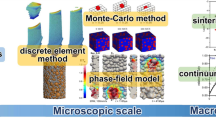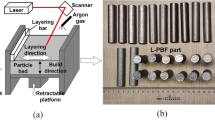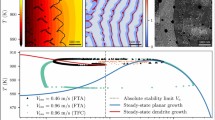Abstract
Transient liquid-phase infiltration (TLI) involves a powder-metal skeleton and an infiltrant with similar composition containing a melting-point depressant (MPD). Upon infiltration, the MPD diffuses into the skeleton, causing isothermal solidification and allowing a homogeneous final-part composition. Diffusional solidification of the infiltrant can restrict liquid flow and result in premature freeze-off if the liquid solidifies before filling the entire part. A capillary-driven fluid-flow model was developed to predict the infiltration rate and freeze-off limit using a variable skeleton permeability. Diffusional solidification was measured via quenching experiments, compared to theory, and used to define the change in permeability of the skeleton. The infiltration rate was measured via mass increase and compared to the flow model for various skeletons with powder sizes ranging from 60 to 300 µm. The predicted horizontal infiltration freeze-off limits were proportional to the square root of d 3 γ/μDβ 2, where d is the average powder diameter, γ and μ are the infiltrant surface tension and viscosity, respectively, D is the solid diffusivity, and β is a function of the solidus and liquidus concentrations. These relations can be used for selection of processing parameters and for evaluation of new material systems.
Similar content being viewed by others
References
Adam Lorenz, Emanuel Sachs, Samuel Allen, Lukas Rafflenbeul, and Brian Kernan: Metall. Mater. Trans. A, 2004, vol. 35A, pp. 631–40.
Merton C. Flemings: Solidification Processing, McGraw-Hill, New York, NY, 1974, pp. 219–39.
A. Mortensen, L.J. Masur, J.A. Cornie, and M.C. Flemings: Metall. Mater. Trans. A, 1989, vol. 20A, pp. 2535–47.
L.J. Masur, A. Mortensen, J.A. Cornie, and M.C. Flemings: Metall. Mater. Trans. A, 1989, vol. 20A, pp. 2549–57.
Robert P. Messner and Yet-Ming Chiang: J. Am. Ceram. Soc., 1990, vol. 73 (5), pp. 1193–200.
Yet-Ming Chiang, Robert P. Messner, Chrysanthe D. Terwilliger, and Donald R. Behrendt: Mater. Sci. Eng. 1991, vol. A144, pp. 63–74.
H. Zhuang, J. Chen, and E. Lugscheider: Welding World, 1986, vol. 24 (9–10), pp. 200–08.
W.D. Kingery, H.K. Bowen, and D.R. Uhlmann: Introduction to Ceramics, 2nd ed., John Wiley & Sons, New York, NY, 1976, p. 185.
George W. Scherer: J. Non-Crystalline Solids, 1987, vol. 92, pp. 375–82.
Adam Lorenz: Ph.D. Thesis, MIT, Cambridge, MA, 2002.
Adrian E. Scheidegger: The Physics of Flow through Porous Media, 3rd ed., University of Toronto Press, Toronto, Canada, 1974.
George B. Thomas, Jr. and Ross L. Finney: Calculus and Analytic Geometry, 8th ed., Addison-Wesley, Reading, MA, 1992, pp. 330 and 354.
H. Mehrer: Diffusion in Solid Metals and Alloys, Landolt-Bornstein New Series III/26, Springer-Verlag, New York, NY, pp. 1–29.
G.H. Geiger and D.R. Poirier: Transport Phenomena in Metallurgy, Addison-Wesley, Reading, MA, 1980, pp. 473–96.
W.D. MacDonald and T.W. Eagar: Metall. Mater. Trans. A, 1998, vol. 29A, pp. 315–25.
R.A. Tanzilli and R.W. Heckel: Trans. TMS-AIME, 1968, vol. 242, pp. 2313–21.
Peter J. Heinzer: ASM Handbook, vol. 7, Powder Metallurgy, ASM, Metals Park, OH, 1984, pp. 263–65.
ASM Handbook, vol. 3, Alloy Phase Diagrams, ASM, Metals Park, OH, 1992.
Takamichi Iida and Roderick I.L. Guthrie, The Physical Properties of Liquid Metals, Clarendon Press, Oxford, United Kingdom, 1988, pp. 47–77 and 109–98.
Neil Kensington Adam: The Physics and Chemistry of Surfaces, 3rd ed., Oxford University Press, London, United Kingdom, 1941, pp. 383–84 and 393.
Smithells Metals Reference Book, 7th ed., E.A. Brandes and G.B. Brook, eds., Butterworth Heinemann, Oxford, United Kingdom, 1992.
Isaac Tuah-Poku, M. Dollar, and T.B. Massalski: Metall. Trans. A, 1988, vol. 19A, pp. 675–86.
H. Kokawa, C.H. Lee, and T.H. North: Metall. Trans. A, 1991, vol. 22A, pp. 1627–31.
Y. Zhou, W.F. Gale and T.H. North: Int. Mater. Rev., 1995, vol. 40 (5), pp. 181–96.
Kazuyoshi Saida, Yunhong Zhou, and Thomas H. North: J. Jpn Inst. Met., 1994, vol. 58 (7), pp. 810–18.
Author information
Authors and Affiliations
Rights and permissions
About this article
Cite this article
Lorenz, A., Sachs, E. & Allen, S. Freeze-off limits in transient liquid-phase infiltration. Metall Mater Trans A 35, 641–653 (2004). https://doi.org/10.1007/s11661-004-0376-1
Received:
Issue Date:
DOI: https://doi.org/10.1007/s11661-004-0376-1




